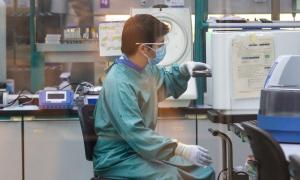3 years of COVID-19: from emergency research to a consolidated study area

In March 2020, IrsiCaixa, CReSA and BSC-CNS, with the support of Grifols, combined areas of expertise to tackle the new virus and are currently studying new tools against SARS-CoV-2 and other emerging viruses
With 120 deaths and more than 4,000 people infected, in March 2020, Spain –the second country in Europe, after Italy, with the most cases reported at that time– declared a state of alarm for the management of the health crisis caused by the new coronavirus. To tackle this devastating pandemic, the IrsiCaixa AIDS Research Institute, the Animal Health Research Centre (CReSA) of the Institute of Agri-Food Research and Technology (IRTA) and the Barcelona Supercomputing Center–Centro Nacional de Supercomputación (BSC), with the support of Grifols, merged their areas of expertise –human health, animal health and supercomputing, respectively– and created the CBIG consortium, which made it possible to undertake joint research projects to find solutions to COVID-19.
Three years later, and with many more tools available to tackle COVID-19, the pandemic figures are beginning to improve and what was once emergency research is now a consolidated line of study. "Thanks to all the knowledge generated in record time, and the knowledge that continues to be generated today, scientific community senses the beginning of the end of the COVID-19 pandemics," says Bonaventura Clotet, director of IrsiCaixa.
Research during the pandemic, a live investigation
The health emergency meant there was an urgent need to generate knowledge and produce tools for diagnosis, prevention and treatment. Since its creation, the team has demonstrated the effectiveness of certain antiviral drugs against SARS-CoV-2, such as plitidepsin or cyclodextrins, but has also ruled out others, such as hydroxychloroquine. In terms of virus detection, the team validated the efficacy of the antigen tests and how this was modified depending on the mutations acquired by SARS-CoV-2. "All the research we were doing at the time had an immediate effect on how we treated the disease. Both positive and negative results were key to providing the best care for patients as a whole, and to stopping transmission. That is why they were published in open access. In this way we avoided the delay involved in publishing in scientific journals," recalls Julià Blanco, IGTP researcher at IrsiCaixa. "This, however, is not the usual pace of science, which usually requires longer deadlines and does not concentrate all the global research on a single objective," he adds.
At the same time, the consortium was designing a new vaccine prototype. "We have analysed the possible molecular structures of the Spike protein and its receptor to identify candidate vaccine molecules," explains Víctor Guallar, head of the BSC's electronic and atomic modelling of proteins group. Thanks to these studies, different vaccine prototypes have been detected and found to be effective in animal models. "To create the vaccine, we used recombinant proteins focused on the spike structure, which is the target of neutralising antibodies. We have seen that this prototype could be capable of preventing the development of the disease," explains Jorge Carrillo, researcher at IrsiCaixa. The team also carried out, and still does, exhaustive monitoring of the population's neutralising antibodies, a data that provides information on the level of protection people have against COVID-19.
Another key point during the pandemic has been to understand which animals are susceptible to SARS-CoV-2 infection. "We know that cats, dogs, ferrets and lions, among others, can be naturally infected by SARS-CoV-2," says Joaquim Segalés, researcher at IRTA-CReSA and professor at the Autonomous University of Barcelona (UAB). "Having this knowledge is important to know which could be the potential reservoirs of the virus," adds Júlia Vergara-Alert, researcher at IRTA-CReSA.
At the same time as the scientific research was being carried out, the team had to overcome logistical challenges. "Working with viruses that are transmitted via the respiratory tract requires very strict security measures, and we had to set up the laboratories we already had and create new ones to be able to start the studies quickly," explains Blanco, who is grateful for the complicity with the CMCiB-IGTP Centre for Bioimaging and Comparative Medicine. Once enabled, these laboratories allowed, and continue to allow, other research projects with different pathogens to be carried out.
Where we are and where we are going
Every day, around 145,000 SARS-CoV-2 infections and 960 COVID-19 deaths are reported worldwide, figures that have fallen by 69% and 89%, respectively, in the last month. This decline has been largely due to vaccines, the pandemic's quintessential allies in halting the progression of the severity of COVID-19. Unlike HIV, for which we have treatments but no vaccines, vaccines have been developed against SARS-CoV-2, but work is still underway to find effective drugs to eliminate the virus from the body. "Apart from identifying which drugs might be useful against SARS-CoV-2, it is also important to decipher the underlying mechanism of action, as this would allow us to find out which treatments might be effective against SARS-CoV-2 and, at the same time, to understand which would work against other viruses. Knowing in detail how the drugs work would help to have a battery of potential compounds ready for use in future pandemics," explains Nuria Izquierdo-Useros, principal investigator at IrsiCaixa.
Zoonotic leaps have been described throughout human history, and continue to happen today. "We need to accumulate knowledge in order to be prepared for current threats, but also for those that may emerge. Merging the research fields of the three centres that make up the CBIG consortium allows us to work under the One Health perspective, which consists of understanding health as the whole of human, animal and environmental health," says Clotet. "This way of working is imperative to be able to face and anticipate future pandemics," he concludes.